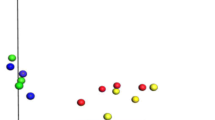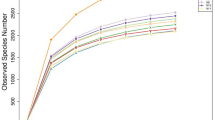Abstract
In addition to a wide variety of anaerobic and facultative anaerobic bacteria, camel rumen also harbors a diverse of eukaryotic organisms. In the present study, the eukaryotic communities of camel rumen were characterized using 18S rRNA amplicon sequencing. Metagenomic DNA was isolated from rumen samples of fourteen adult Bikaneri and Kachchhi breeds of camel fed different diets containing Jowar, Bajra, Maize, and Guar. Illumina sequencing generated 27,161,904 number of reads corresponding to 1543 total operational taxonomic units (OTUs). Taxonomic classification of community metagenome sequences from all the samples revealed the presence of 92 genera belonging to 16 different divisions, out of which Ciliophora (73%), Fungi (13%) and Streptophyta (9%) were found to be the most dominant. Notably, the abundance of Ciliophora was significantly higher in the case of Guar feed, while Fungi was significantly higher in the case of Maize feed, indicating the influence of cellulose and hemicellulose content of feedstuff on the composition of eukaryotes. The results suggest that the camel rumen eukaryotes are highly dynamic and depend on the type of diet given to the animal. Pearson’s correlation analysis suggested the ciliate protozoa and fungi were negatively correlated with each other. To the best of our knowledge, this is first systematic study to characterize camel rumen eukaryotes, which has provided newer information regarding eukaryotic diversity patterns amongst camel fed on different diets.







Similar content being viewed by others
Availability of data and materials
The sequences for this study have been deposited in the NCBI-SRA under the BioProject PRJNA603266.
References
Akin DE, Borneman WS (1990) Role of rumen fungi in fiber degradation. J Dairy Sci 73(10):3023–3032. https://doi.org/10.3168/jds.S0022-0302(90)78989-8
Albertin W, Setati ME, Miot-Sertier C, Mostert TT, Colonna-Ceccaldi B, Coulon J, Girard P, Moine V, Pillet M, Salin F, Bely M, Divol B, Masneuf-Pomarede I (2016) Hanseniaspora uvarum from winemaking environments show spatial and temporal genetic clustering. Front Microbiol. https://doi.org/10.3389/fmicb.2015.01569
Alipour D (2012) Ruminal ciliated protozoa in Baloochi and Sindhi Camel breeds. J Vet Res 67(3):257–263
Almeida PNMd, Duarte ER, Abrão FO, Freitas CES, Geraseev LC, Rosa CA (2012) Aerobic fungi in the rumen fluid from dairy cattle fed different sources of forage. R Bras Zootec 41(11):2336–2342
Ando S, Nishiguchi Y, Hayasaka K, Iefuji H, Takahashi J (2006) Effects of Candida utilis Treatment on the nutrient value of rice bran and the effect of Candida utilis on the degradation of forages in vitro. Asian Australas J Anim Sci 19(6):806–810. https://doi.org/10.5713/ajas.2006.806
Barbosa Junior AM, Santos BFdO, Carvalho EdO, Mélo DLFMd, Trindade RdC, Stoianoff MAdR (2013) Biological activity of Cryptococcus neoformans and Cryptococcus gattii from clinical and environmental isolates. J Bras Patol Med Lab 49(3):160–168
Belzecki G, Miltko R, Kwiatkowska E, Michalowski T (2013) The ability of rumen ciliates, Eudiplodinium maggii, Diploplastron affine, and Entodinium caudatum, to use the murein saccharides. Folia Microbiol 58(6):463–468. https://doi.org/10.1007/s12223-013-0231-0
Bonhomme A (1990) Rumen ciliates: their metabolism and relationships with bacteria and their hosts. Anim Feed Sci Tech 30(3–4):203–266
Callahan BJ, McMurdie PJ, Rosen MJ, Han AW, Johnson AJA, Holmes SP (2016) DADA2: high-resolution sample inference from Illumina amplicon data. Nat Methods 13(7):581
Caporaso JG, Kuczynski J, Stombaugh J, Bittinger K, Bushman FD, Costello EK, Fierer N, Pena AG, Goodrich JK, Gordon JI (2010) QIIME allows analysis of high-throughput community sequencing data. Nat Methods 7(5):335
Coleman G (1989) Protozoal-bacterial interaction in the rumen. The roles of protozoa and fungi in ruminant digestion. Penambul Books, Armidale, pp 13–27
Das B, Arora S, Luthra Y (1975) Variability in structural carbohydrates and in vitro digestibility of forages. 3. Guar (Cyamopsis tetragonoloba). J Dairy Sci 58(9):1347–1351
Dehority BA (2017) Laboratory manual for classification and morphology of rumen ciliate protozoa. CRC Press, US
Dunthorn M, Klier J, Bunge J, Stoeck T (2012) Comparing the hyper-variable V4 and v9 regions of the small subunit rDNA for assessment of ciliate environmental diversity. J Eukaryot Microbiol 59(2):185–187. https://doi.org/10.1111/j.1550-7408.2011.00602.x
Ellis JE, Williams A, Lloyd D (1989) Oxygen consumption by ruminal microorganisms: protozoal and bacterial contributions. Appl Environ Microbiol 55(10):2583–2587
Eugène M, Archimede H, Sauvant D (2004) Quantitative meta-analysis on the effects of defaunation of the rumen on growth, intake and digestion in ruminants. Livest Prod Sci 85(1):81–97
Gow NA, Yadav B (2017) Microbe profile: Candida albicans: a shape-changing, opportunistic pathogenic fungus of humans. Microbiology 163(8):1145–1147
Gürelli G, Canbulat S, Aldayarov N, Dehority BA (2016) Rumen ciliate protozoa of domestic sheep (Ovis aries) and goat (Capra aegagrus hircus) in Kyrgyzstan. FEMS Microbiol Lett. https://doi.org/10.1093/femsle/fnw028
Hadziavdic K, Lekang K, Lanzen A, Jonassen I, Thompson EM, Troedsson C (2014) Characterisation of the 18S rRNA gene for designing universal eukaryote specific primers. PLoS ONE 9(2):e87624–e87624. https://doi.org/10.1371/journal.pone.0087624
Harinarayana G, Melkania N, Reddy B, Gupta S, Rai K, Kumar PS (2005) Forage potential of sorghum and pearl millet. Biofortified Crops for Human Nutrition. West Lafayette, IN, pp 292–321
Ho YW, Barr DJS (1995) Classification of anaerobic gut fungi from herbivores with emphasis on rumen fungi from Malaysia. Mycologia 87(5):655–677. https://doi.org/10.2307/3760810
Hubenova Y, Mitov M (2010) Potential application of Candida melibiosica in biofuel cells. Bioelectrochemistry 78(1):57–61. https://doi.org/10.1016/j.bioelechem.2009.07.005
Hugerth LW, Muller EEL, Hu YOO, Lebrun LAM, Roume H, Lundin D, Wilmes P, Andersson AF (2014) Systematic design of 18S rRNA gene primers for determining eukaryotic diversity in microbial consortia. PLoS ONE 9(4):e95567–e95567. https://doi.org/10.1371/journal.pone.0095567
Ishaq SL, AlZahal O, Walker N, McBride B (2017) An investigation into rumen fungal and protozoal diversity in three rumen fractions, during high-fiber or grain-induced sub-acute ruminal acidosis conditions, with or without active dry yeast supplementation. Front Microbiol 8:1943. https://doi.org/10.3389/fmicb.2017.01943
Jančič S, Nguyen HD, Frisvad JC, Zalar P, Schroers H-J, Seifert KA, Gunde-Cimerman N (2015) A taxonomic revision of the Wallemia sebi species complex. PLoS ONE 10(5):e0125933
Katoh K, Standley DM (2013) MAFFT multiple sequence alignment software version 7: improvements in performance and usability. Mol Biol Evol 30(4):772–780
Kittelmann S, Janssen PH (2011) Characterisation of rumen ciliate community composition in domestic sheep, deer, and cattle, feeding on varying diets, by means of PCR-DGGE and clone libraries. FEMS Microbiol Ecol 75(3):468–481
Kittelmann S, Seedorf H, Walters WA, Clemente JC, Knight R, Gordon JI, Janssen PH (2013) Simultaneous amplicon sequencing to explore co-occurrence patterns of bacterial, archaeal and eukaryotic microorganisms in rumen microbial communities. PLoS ONE 8(2):e47879–e47879
Kittelmann S, Devente SR, Kirk MR, Seedorf H, Dehority BA, Janssen PH (2015) Phylogeny of intestinal ciliates, including Charonina ventriculi, and comparison of microscopy and 18S rRNA gene pyrosequencing for rumen ciliate community structure analysis. Appl Environ Microbiol 81(7):2433–2444
Kurihara Y, Eadie JM, Hobson P, Mann S (1968) Relationship between bacteria and ciliate protozoa in the sheep rumen. Microbiology 51(2):267–288
Ljungdahl LG (2008) The cellulase/hemicellulase system of the anaerobic fungusorpinomycesPC-2 and aspects of its applied use. Ann N Y Acad Sci 1125(1):308–321
Mada PK, Jamil RT, Alam MU (2019) Cryptococcus (Cryptococcosis). StatPearls Publishing, Treasure Island (FL)
McAllister T, Bae H, Jones G, Cheng K-J (1994) Microbial attachment and feed digestion in the rumen. J Anim Sci 72(11):3004–3018
Mehta SC, Mishra BP, Sahani MS (2006) Genetic differentiation of Indian camel (Camelus dromedarius) breeds using random oligonucleotide primers. Anim Genet Resour 39:77–88. https://doi.org/10.1017/S1014233900002157
Moreira N, Pina C, Mendes F, Couto JA, Hogg T, Vasconcelos I (2011) Volatile compounds contribution of Hanseniaspora guilliermondii and Hanseniaspora uvarum during red wine vinifications. Food Control 22(5):662–667. https://doi.org/10.1016/j.foodcont.2010.07.025
Netzel G, Tan ETT, Yin M, Giles C, Yong K, Al Jassim R, Fletcher M (2019) Bioaccumulation and distribution of indospicine and its foregut metabolites in camels fed indigofera spicata. Toxins 11(3):162. https://doi.org/10.3390/toxins11030169
Orpin C, Joblin K (1997) The rumen anaerobic fungi. The rumen microbial ecosystem. Springer, Dordrecht, pp 140–195
Oxford A (1958) Bloat in cattle: IX. Some observations on the culture of the cattle rumen ciliate Epidinium ecaudatum crawley occurring in quantity in cows fed on red clover (Trifolium pratense L.). New Zealand J Agric Res. 1(6):809–824
Parks DH, Tyson GW, Hugenholtz P, Beiko RG (2014) STAMP: statistical analysis of taxonomic and functional profiles. Bioinformatics 30(21):3123–3124. https://doi.org/10.1093/bioinformatics/btu494
Price MN, Dehal PS, Arkin AP (2010) FastTree 2–approximately maximum-likelihood trees for large alignments. PLoS ONE 5(3):e9490
Qi M, Wang P, O’Toole N, Barboza PS, Ungerfeld E, Leigh MB, Selinger LB, Butler G, Tsang A, McAllister TA (2011) Snapshot of the eukaryotic gene expression in muskoxen rumen—a metatranscriptomic approach. PLoS ONE 6(5):e20521
Rabee AE, Forster RJ, Elekwachi CO, Kewan KZ, Sabra EA, Shawket SM, Mahrous HA, Khamiss OA (2019) Community structure and fibrolytic activities of anaerobic rumen fungi in dromedary camels. J Basic Microbiol 59(1):101–110. https://doi.org/10.1002/jobm.201800323
Refai M, Elhariri M, Alarousy R (2017) Cryptococcosis in Animals and Birds: A Review, vol 4
Rocha-Meneses L, Raud M, Orupõld K, Kikas T (2017) Second-generation bioethanol production: a review of strategies for waste valorisation. Agron Res 15(3):830–847
Samsudin AA, Wright A-DG, Al Jassim R (2012) Investigation into the cellulolytic bacteria in the foregut of the Dromedary Camel (Camelus dromedarius). Appl Environ Microbiol 78(24):8836–8839
Segata N, Izard J, Waldron L, Gevers D, Miropolsky L, Garrett WS, Huttenhower C (2011) Metagenomic biomarker discovery and explanation. Genome Biol 12(6):R60
Selim HM, Imai S, Yamato O, Miyagawa E, Maede Y (1996) Ciliate protozoa in the forestomach of the dromedary camel, (Camelus dromedarius), in Egypt, with description of a new species. J Vet Med Sci 58(9):833–837
Shin EC, Cho KM, Lim WJ, Hong SY, An CL, Kim EJ, Kim YK, Choi BR, An JM, Kang JM, Kim H, Yun HD (2004) Phylogenetic analysis of protozoa in the rumen contents of cow based on the 18S rDNA sequences. J Appl Microbiol 97(2):378–383. https://doi.org/10.1111/j.1365-2672.2004.02304.x
Singh K, Pandya P, Tripathi A, Patel G, Parnerkar S, Kothari R, Joshi C (2013) Molecular diversity of protozoa in rumen of Indian buffalo (Bubalus bubalis). Agric Res 2(4):360–366
Sipiczki M, Tap RM (2016) Candida vulturna pro tempore sp. nov., a dimorphic yeast species related to the Candida haemulonis species complex isolated from flowers and clinical sample. Int J Syst Evol Microbiol 66(10):4009–4015. https://doi.org/10.1099/ijsem.0.001302
Sirisan V, Pattarajinda V, Vichitphan K, Leesing R (2013) Isolation, identification and growth determination of lactic acid-utilising yeasts from the ruminal fluid of dairy cattle. Lett Appl Microbiol 57(2):102–107. https://doi.org/10.1111/lam.12078
Small EB (1976) A proposed subphyletic division of the phylum Ciliophora Doflein, 1901. Trans Am Microsc Soc 95:739–751
Sylvester JT, Karnati SK, Yu Z, Morrison M, Firkins JL (2004) Development of an assay to quantify rumen ciliate protozoal biomass in cows using real-time PCR. J Nutr 134(12):3378–3384
Takizawa S, Baba Y, Tada C, Fukuda Y, Nakai Y (2019) Preservation of rumen fluid for the pretreatment of waste paper to improve methane production. Waste Manage 87:672–678
Veira DM (1986) The role of ciliate protozoa in nutrition of the ruminant. J Anim Sci 63(5):1547–1560
Williams AG (1986) Rumen holotrich ciliate protozoa. Microbiol Rev 50(1):25
Williams A, Coleman G (1997) The rumen protozoa. The rumen microbial ecosystem. Springer, Germany, pp 73–139
Acknowledgements
This research work was financially supported by the Department of Biotechnology (DBT), Ministry of Science and Technology, Government of India, New Delhi; Reference No.: BT/PR15586/AAQ/1/651/2015.
Author information
Authors and Affiliations
Contributions
HJP and CGJ conceptualised the experimental design, NVP performed the feeding experiment, SJJ and NAD performed sample collection. NJT and PM performed DNA isolation, sequencing, bioinformatics analysis, and initial manuscript writing; SJJ, PGK and NAD improved the manuscript.
Corresponding author
Ethics declarations
The experiment was performed under the approval of the institutional animal ethics committee of the National Research Center on Camel, Bikaner, Rajasthan.
Conflict of interest
The authors declare that they have no conflict of interest.
Additional information
Communicated by Erko Stackebrandt.
Publisher's Note
Springer Nature remains neutral with regard to jurisdictional claims in published maps and institutional affiliations.
Electronic supplementary material
Below is the link to the electronic supplementary material.
Rights and permissions
About this article
Cite this article
Mishra, P., Tulsani, N.J., Jakhesara, S.J. et al. Exploring the eukaryotic diversity in rumen of Indian camel (Camelus dromedarius) using 18S rRNA amplicon sequencing. Arch Microbiol 202, 1861–1872 (2020). https://doi.org/10.1007/s00203-020-01897-w
Received:
Revised:
Accepted:
Published:
Issue Date:
DOI: https://doi.org/10.1007/s00203-020-01897-w




